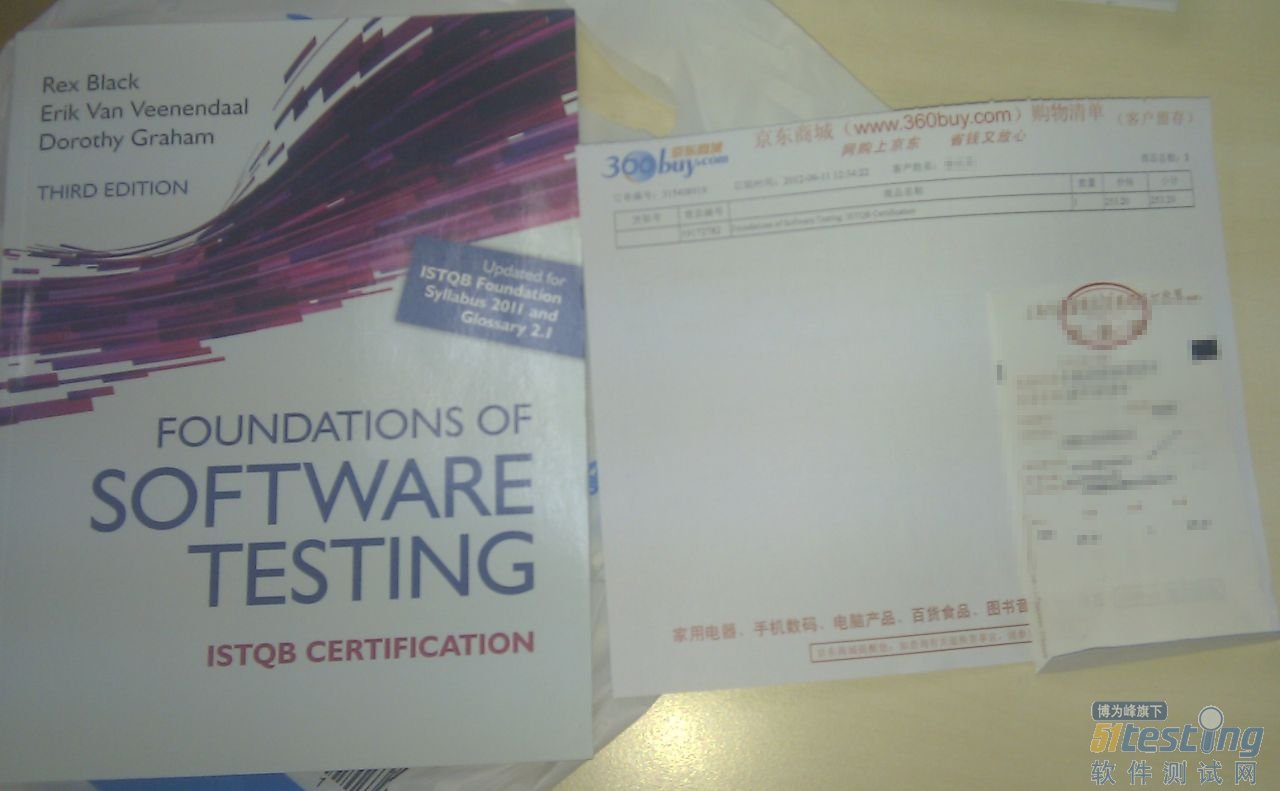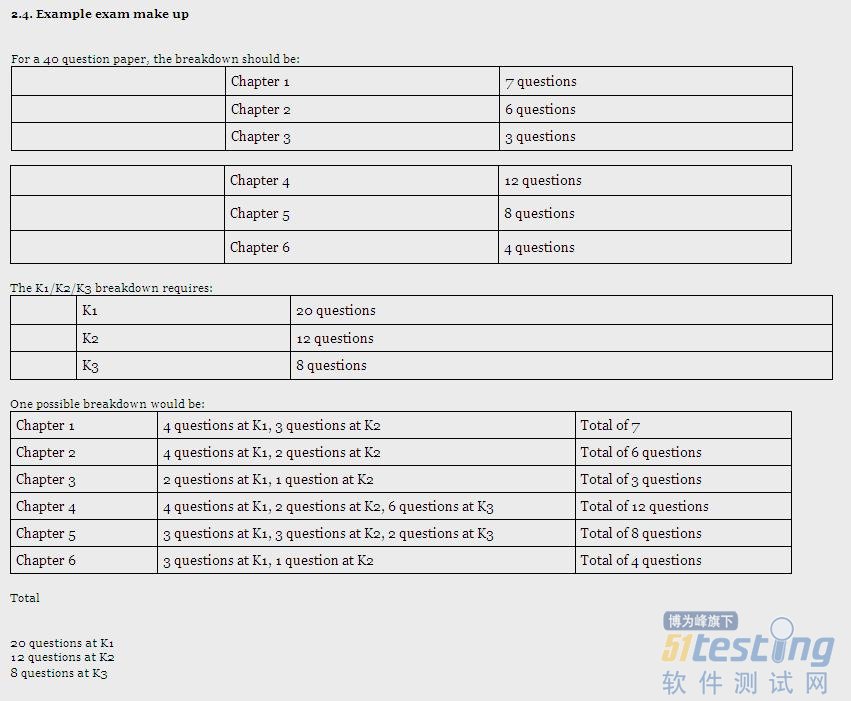-
Verification and Vaildation 辨别
2012-09-28 09:57:11
Verification: Confirmation by examination and through provision of objective evidence that specified requirements havebeen fulfilled. [ISO 9000]
验证:通过检查和提供客观证据来证实指定的需求是否已经满足。[ISO 9000]
Validation: Confirmation by examination and through provision of objective evidence that
the requirements for a specific intended use or application have been fulfilled. [ISO 9000]确认:通过检查和提供客观证据来证实特定目的功能或应用已经实现。[ISO 9000]
辨析:验证(verification) 产品是否正确的按着设计文档实现功能。确认(validation) 产品是否正确的按着客户需求被实现功能。 也就是产品通过了验证测试但是不一定会通过确认测试。这也就是为什么要提早介入测试,让设计文档尽可能准确的符合需求文档的要求。需求和设计文档之间的Gap越小,两种测试就越可能得到相同的结果。
-
EDS -ISTQB-模拟题-Module1 错题解析
2012-09-23 20:15:58
1. In prioritising what to test, the most important objective is to:
A. find as many faults as possible
B. test high risk areas
C. obtain good test coverage
D. test whatever is easiest to test
Answer: B
3. A failure is:
A. an incorrect step, process or data definition in a computer program
B. found in the software; the result of an error
C. departure from specified behavior
D. a human action that produces an incorrect result
Answer: C
5. What is the purpose of testing?
A. to detect and prevent defects
B. to measure how closely the system conforms to its requirements
C. to provide manager with information about the progress of a project
D. all of the above answers are correct
Answer: D
6. Which of the following statements about Testing and Debugging is NOT correct?
A. Debugging checks that the defect has been fixed correctly
B. Testing ensures that the fix does indeed resolve the failure
C. Testing checks that the defect has been fixed correctly
D. Debugging identifies the cause of a defect and repairs the code
Answer: C
8. When should testing begin?
A. after construction
B. after producing the first project deliverable
C. after implementation
D. whenever time permits
Answer: B
-
Foundations Of Software Testing ISTQB Certification(3rd)
2012-09-17 16:52:04
-
关于FL考试的考题分布
2012-09-11 11:01:26
至郑文强老师的一封信:
郑文强老师,您好!
有幸在你的CSDN个人空间里获得了一些关于ISTQB的资料,对我的FL的考试非常有帮助,再次表达我的感谢之情。 另外,我看到你的 “ISTQB FL初级认证系列01:ISTQB FL初级认证考试说明” 中,对FL考试的考题分布有详细的介绍,但是,内容应该是基于2007年的考纲的吧? 因为,我发现知识点的基本还只限于K1,K2,K3. 在2011年的新考纲里有一个新的K4基本的知识点了,我在CSTQB的网上了找不类似的介绍, 请问您是否能提供这方面的资料? 或者能否在你百忙之中更新一下这个内容吗? 非常感谢,您的读者郑老师的回复:你好:非常感谢你的来信,从心中可以看出你对ISTQB已经有相当的了解。 ISTQB考证说明中FL的考题分布, 确实是基于2007版本的。目前就一个内容有所更改, 即一道K4的题目代替了原来K3的题目:白盒测试中的内容。 因为CSTQB官方没有这个最新的更新,所以我也没有计划更新。 从考试层面而言,白盒测试中的内容,你不用太关心, 实际内容没有什么变化。 有任何ISTQB方面的疑问,欢迎来信,或者访问我的个人网站:http://www.skyqa.com 。祝好郑文强 -
ISTQB - 模拟题错误解析
2012-09-06 17:19:03
1. (K1) 下列关于错误、缺陷和失效的观点正确的是:
A) 人都会犯错误,因此在由人设计的程序也会引入缺陷;
B) 所有的缺陷都会产生失效;
C) 失效主要是由人的错误造成的,和环境条件没有关系;
D) 当存在缺陷的代码被执行时,才可能引发软件错误。答案: 我选D, 但是答案是A
解析:粗心没好好看题,答案D应该是“引发软件失效”,用排除法得到答案A。
5. (K2) 下列关于不同的测试阶段的描述错误的是:
A) 维护测试通常是为了验证开发过程发现的缺陷是否被正确修复。
B) 组件测试的主要目标是尽可能的发现失效,从而识别和修正尽可能多的缺陷。
C) 验收测试的主要目标是确认系统是否按照预期工作,是建立满足了需求的信心。
D) 不同测试阶段,其测试目标是不同的。答案: 我选B, 但是答案是A
解析:FL考纲2011版P14页:“维护测试通常是为了验证在开发过程中的软件变
更是否引入新的缺陷”。 而P30页:“当发现和修改了一个缺陷后,应进行再测试以确定已经成功的修改了原来的缺陷,这称之为确认。”,这样看来答案A的叙述是错误的。7. (K2) 规划测试环境的搭建和确定测试需要的基础设施和工具属于下面的哪个活动?
(A) 计划和控制
(B) 分析和设计
(C) 实现和执行
(D) 评估出口准则和报告答案: 我选A, 但是答案是B
解析:这个是被书“软件测试基础教程”的“2.2.1测试计划和控制”一节误导了,这节最后讲到了基础设施和测试工具需要开发的问题,就误认为A了。这部分内容在考纲P17页有很清楚的表述。
8. A test team consistently finds between 90% and 95% of the defects present in the system under test. While the test manager understands that this is a good defect-detection percentage for her test team and industry, senior management and executives remain disappointed in the test group, saying that the test team misses too many bugs. Given that the users are generally happy with the system and that the failures which have occurred have generally been low impact,which of the following testing principles is most likely to help the test manager explain to these managers and executives why some defects are likely to be missed?
a. Exhaustive testing is impossible
b. Defect clustering
c. Pesticide paradox
d. Absence-of-errors fallacy答案: 我选B, 但是答案是A
解析:这个题很容易被90%~95%迷惑,粗心就选择B了,但是题目里表达了,发现了绝大部分Defect,并且剩余的问题对用户影响不大,因此给管理者的解释告诉他们避免全部的问题是不可能的,做到把影响大的问题最大程度发现是有可能的。
-
ISTQB-FL-考纲-2007(蓝色)Vs.2011(黑色)
2012-08-30 10:14:30
The syllabus of ISTQB Foundation Level
2007(Blue) Vs. 2011(Black)
• K1: remember, recognize, recall;
• K1: remember
• K2: understand, explain, give reasons, compare, classify, categorize, give examples, summarize;
• K2: understand
• K3: apply, use.
• K3: apply
• K4: (No Exist)
• K4: analyze
1. Fundamentals of Testing (K2)
1.1 Why is testing necessary? (K2)
LO-1.1.5 Recall the terms error, defect, fault, failure and corresponding terms mistake and bug. (K1)
LO-1.1.5 Explain and compare the terms error, defect, fault, failure, and the corresponding terms mistake and bug, using examples (K2)
1.2 What is testing? (K2)
LO-1.2.2 Describe the purpose of testing in software development, maintenance and operations as a means to find defects, provide confidence and information, and prevent defects. (K2)
LO-1.2.2 Provide examples for the objectives of testing in different phases of the software life cycle (K2)
LO-1.2.3 (No Exist)
LO-1.2.3 Differentiate testing from debugging (K2)
2. Testing Throughout the Software Life Cycle (K2)
2.1 Software development models (K2)
LO-2.1.1 Understand the relationship between development, test activities and work products in the development life cycle, and give examples based on project and product characteristics and context (K2).
LO-2.1.1 Explain the relationship between development, test activities and work products in the development life cycle, by giving examples using project and product type (K2).
3. Static techniques (K2)
3.1 Static techniques and the test process (K2)
LO-3.1.3 Explain the difference between static and dynamic techniques. (K2)
LO-3.1.4 Describe the objectives of static analysis and reviews and compare them to dynamic testing. (K2)
LO-3.1.3 Explain the difference between static and dynamic techniques, considering objectives, types of defects to bee identified, and the role of these techniques within the software life cycle (K2)
3.3 Static analysis by tools (K2)
LO-3.3.2 List typical benefits of static analysis. (K1)
LO-3.3.2 Describe, using examples, the typical benefits of static analysis (K2)
4. Test design techniques (K4) * (K3 --> K4)
4.1 The test development process (K3) * (K2 --> K3)
LO-4.1.3 Evaluate the quality of test cases. Do they:
• show clear traceability to the requirements;
• contain an expected result. (K2)
LO-4.1.3 Evaluate the quality of test cases in terms of clear traceability to the requirements and expected results (K2)
4.3 Specification-based or black-box techniques (K3)
LO-4.3.1 Write test cases from given software models using the following test design techniques: (K3)
• Equivalence partitioning;
• Boundary value analysis;
• Decision table testing;
• State transition testing.
LO-4.3.1Write test cases from given software models using equivalence partitioning, boundary value analysis, decision tables and state transition diagrams/tables (K3)
LO-4.3.2 Understand the main purpose of each of the four techniques, what level and type of testing could use the technique, and how coverage may be measured. (K2)
LO-4.3.2 Explain the main purpose of each of the four testing techniques, what level and type of testing could use thee technique, and how coverage may be measured (K2)
LO-4.3.3 Understand the concept of use case testing and its benefits. (K2)
LO-4.3.3 Explain the concept of use case testing and its benefits (K2)
4.4 Structure-based or white-box techniques (K4) * (K3 --> K4)
LO-4.4.2 Explain the concepts of statement and decision coverage, and understand that these concepts can also be used at other test levels than component testing (e.g. on business procedures at system level). (K2)
O-4.4.2 Explain the concepts of statement and decision coverage, and give reasons why these concepts can also bee used at test levels other than component testing (e.g., on business procedures at system level) (K2)
LO-4.4.3 Write test cases from given control flows using the following test design techniques:
• Statement testing;
• Decision testing. (K3)
LO-4.4.3 Write test cases from given control flows using statement and decision test design techniques (K3)
LO-4.4.4 Assess statement and decision coverage for completeness. (K3)
LO-4.4.4 Assess statement and decision coverage for completeness with respect to defined exit criteria. (K4)
4.6 Choosing test techniques (K2)
LO-4.6.1 List the factors that influence the selection of the appropriate test design technique for a particular kind of problem, such as the type of system, risk, customer requirements, models for use case modeling, requirements models or tester knowledge. (K2)
LO-4.6.1 Classify test design techniques according to their fitness to a given context, for thee test basis, respective models and software characteristics (K2)
5. Test management (K3)
5.1 Test organization (K2)
LO-5.1.2 List the benefits and drawbacks of independent testing within an organization. (K2)
LO-5.1.2 Explain the benefits and drawbacks of independent testing within an organization (K2)
5.2 Test planning and estimation (K3) * (K2 --> K3)
5.3 Test progress monitoring and control (K2)
LO-5.3.2 Understand and interpret test metrics for test reporting and test control (e.g. defects found and fixed, and tests passed and failed). (K2)
LO-5.3.2 Explain and compare test metrics for test reporting and test control (e.g., defects found and fixed, and tests passed and failed) related to purpose and use (K2)
6. Tool support for testing (K2)
6.1 Types of test tool (K2)
LO-6.1.1 Classify different types of test tools according to the test process activities. (K2)
LO-6.1.1 Classify different types of test tools according to their purpose and to the activities of the fundamental test process and the software life cycle (K2)
LO-6.1.2 Recognize tools that may help developers in their testing. (K1)
LO-6.1 .2 Intentionally skipped
LO-6.1.3 (No Exist)
LO-6.1.3 Explain the term test tool and the purpose of tool support for testing (K2)
6.2 Effective use of tools: potential benefits and risks (K2)
LO-6.2.2 Recognize that test execution tools can have different scripting techniques, including data driven and keyword driven. (K1)
LO-6.2.2 Remember special considerations for test execution tools, static analysis, and test management tools (K1)
LO-6.3.2 State the goals of a proof-of-concept/piloting phase for tool evaluation. (K1)
LO-6.3.2 State thee goals of a proof-of-concept for tool evaluation and a piloting phase for tool implementation (K1)
-
再次为ISTQB-FL考试做准备
2012-08-30 09:58:45
在我家领导的催促下,本人再次为ISTQB-FL考试做准备,不参加培训,使用自己手上的现有资料:
1. 以Foundations Of Software Testing ISTQB Certification(3rd)
为主要教材(OReilly上刚刚购入电子版花了好多米...)
2. 结合ISTQB的2011年的Syllabus和Glossary
3. 参考书是《Software_Testing_Foundations_Third_Edition》,主要是它是结合考纲的还有习题,但是买最新版本的是Amazon上太贵也不方便。
4. 可以再看看 EDS的ISTQB Testing Foundation 的Flash教程(内部资料哦)
5. 在教程看的差不多了要试试网上买来的题库,不知道好不好,总算是能做个练习。
6. 最后,花一大笔米去考试,如果不行的话那就杯具了,俺家领导可是给俺花了血本了。。。
-
为ISTQB FL 考试准备
2010-01-28 13:01:35
ISTQB FL - > ISTQB AL -> ISTQB EL
慢慢考吧, 按着这个发展下去,年纪一大把了 再不有点可以拿出手的东西 咋整昵

标题搜索
我的存档
数据统计
- 访问量: 13627
- 日志数: 17
- 建立时间: 2007-01-09
- 更新时间: 2012-09-28



